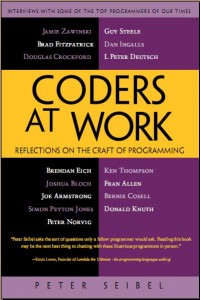Coders at work. A short review
I was visiting my friend before Christmas and on his shelf I found “Coders at Work” by Peter Seibel1. It’s a collection of interviews with fifteen world-known programmers (assuming a programmer can be world-known). Among the names two have caught my eye: Simon Peyton Jones and Guy Steele. I borrowed the book and ended up reading interviews with these two researchers and Donald Knuth. Not surprisingly, interview with Simon Peyton Jones was the one that interested me the most. I found it very enjoyable to read accounts of how these people became programmers in times where computers where huge machines available only at universities. On the other hand I also found some parts of the interviews to be a bit dry, e.g. SPJ goes into the discussion of Software Transactional Memory in Haskell and I think that reader not familiar with STM will not get much out of this. Also, reader familiar with STM will probably not need this discussion.
There are two thoughts that stroke me during the reading. When reading interview with Knuth I realized that there are actually people that are unable to learn programming. I teach at the university and I’ve seen many first year students who completely don’t grasp programming but somehow it never occurred to me that some of them might not ever be able to learn this. Second thought, the more important one, is that all these famous programmers were extremely lucky guys. They all got the chance to develop their talents. I believe that there are even more very talented people who could have had even greater impact on computer science, but they just didn’t get their chance.
One last thing. SPJ mentions that his “Aha!” moment in functional programming was Arthur Norman’s demonstration of implementing double-linked list in a purely functional fashion, that is without any side effects. I tried to google more information on that but with no result. So if anyone has an idea how to implement such a list please tell me. The only thing that comes to my mind are zippers. They do allow traversal of list in both directions and modifying its elements so this might be it.
In fact I found Polish edition.↩︎
